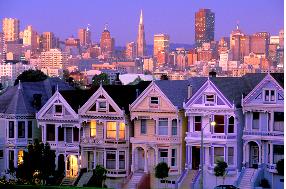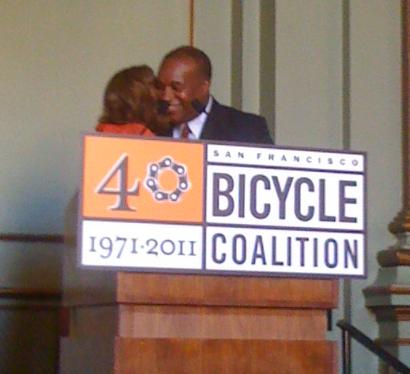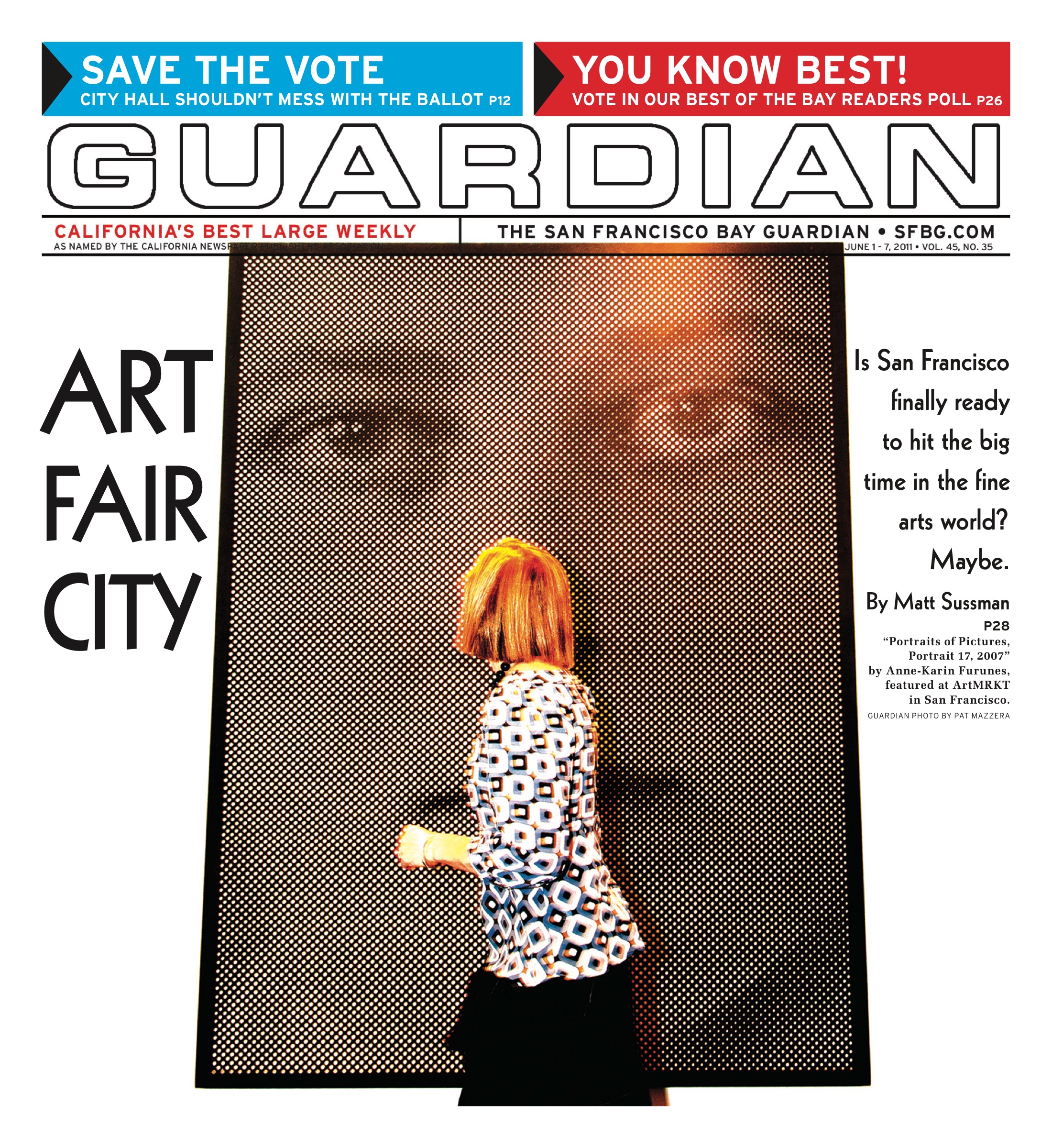Music listings are compiled by Cheryl Eddy. Since club life is unpredictable, it’s a good idea to call ahead to confirm bookings and hours. Prices are listed when provided to us. Submit items for the listings at listings@sfbg.com. For further information on how to submit items for the listings, see Picks.
WEDNESDAY 22
ROCK/BLUES/HIP-HOP
Nikka Costa, Allen Stone, Capra Independent. 8pm, $20.
Terry Evans Biscuits and Blues. 8 and 10pm, $15.
Face to Face, Strung Out, Blitzkid, Darlings Regency Ballroom. 8pm, $27.
Flood, Hollow Mirrors, Owl Knockout. 10pm, $6.
Hex Machine, Dead Meat, Listo Hemlock Tavern. 9pm, $7.
Kid Congo Powers and the Pink Monkey Birds, Non!, Allah-Las, Midnite Snaxx Rickshaw Stop. 8pm, $12.
Kooks Slim’s. 8pm, $25.
Misisipi Mike’s Midnight Gamblers, Female Trouble, Grand Lodge Bottom of the Hill. 9pm, $8.
Panic at the Disco, Fun, Funeral Party Warfield. 7:30pm, $28.
Sands, Zoo Animal, Mike Sempert Hotel Utah. 9pm, $7.
Taking Back Sunday, Thursday, Colour Revolt, New Regime Fillmore. 6:30pm, $27.50.
JAZZ/NEW MUSIC
Monty Alexander Yoshi’s San Francisco. 8pm, $25.
Cat’s Corner with Nathan Dias and Christine Savanna Jazz. 9pm, $10.
Michael Chase, Lorenzo Rite Spot, 2099 Folsom, SF; www.ritespotcafe.net. 9pm, free.
Cosmo Alleycats Le Colonial, 20 Cosmo, SF; www.lecolonialsf.com. 7pm.
Dink Dink Dink, Gaucho, Michael Abraham Amnesia. 7pm, free.
Jaga Jazzist Great American Music Hall. 8pm, $21.
Jazz organ party with Graham Connah Royal Cuckoo, 3202 Mission, SF; www.royalcuckoo.com. 7:30pm, free.
“Kim Nalley Sings Nina Simone” Rrazz Room. 8pm.
Ben Marcato and the Mondo Combo Top of the Mark. 7:30pm, $10.
FOLK/WORLD/COUNTRY
Borucoe and BrazilVox Yoshi’s San Francisco lounge. 9pm, $10.
Kelly McFarling Revolution Café, 3248 22nd St, SF; (415) 642-0474. 8:30pm, free.
Ian McFeron and Alisa Milner Simple Pleasures Café, 3434 Balboa, SF; (415) 387-4022. 8pm.
DANCE CLUBS
Booty Call Q-Bar, 456 Castro, SF; www.bootycallwednesdays.com. 9pm. Juanita Moore hosts this dance party, featuring DJ Robot Hustle.
Buena Onda Little Baobab, 3388 19th St, SF; (415) 643-3558. 10pm, free. Funk, swing, rare grooves, and more with Dr. Musco and guests.
Club Shutter Elbo Room. 10pm, $5. Goth with DJs Nako, Omar, and Justin.
Full-Step! Tunnel Top. 10pm, free. Hip-hop, reggae, soul, and funk with DJs Kung Fu Chris and Bizzi Wonda.
Mary Go Round, the New Generation Lookout, 3600 16th St, SF; www.lookoutsf.com. 10pm, $5. Drag with Suppositori Spelling, Mercedez Munro, and Ginger Snap.
No Room For Squares Som., 2925 16th St, SF; (415) 558-8521. 6-10pm, free. DJ Afrodite Shake spins jazz for happy hour.
THURSDAY 23
ROCK/BLUES/HIP-HOP
Grant Hart, Greg Ashley, Tet Holiday Thee Parkside. 9pm, $10.
Holly Golightly and the Brokeoffs, Ferocious Few, Tumbleweed Wanderers Bottom of the Hill. 9pm, $15.
Jackie Greene Swedish American Hall (upstairs from Café Du Nord). 8pm, $25.
Jorma Kaukonen, David Bromberg Fillmore. 8pm, $30.
Led Zepagain Yoshi’s San Francisco. 8pm, $16.
Big Bill Morganfield Biscuits and Blues. 8 and 10pm, $20.
Bill Orcutt, Derek Monypeny, Jozef Von Wissem, Date Palms Hemlock Tavern. 9pm, $7.
Prids, Homeowners, Books on Tape Knockout. 10pm, $8.
Rooney, Voxhaul Broadcast, Maniac Slim’s. 9pm, $16.
Saints of Ruin, Tokyo Raid, Foreign Cinema Café Du Nord. 8pm, $10.
Thao and Mirah, Bobby, Led to Sea Great American Music Hall. 8pm, $16.
You Are Plural, Pleasants, Odd Bird, Passenger and Pilot Amnesia. 9pm, $7-10.
JAZZ/NEW MUSIC
Dave Parker Quartet Purple Onion, 140 Columbus, SF; (415) 956-1653. 7:30-10:30pm, free.
“Kim Nalley Sings Nina Simone” Rrazz Room. 8pm.
Organsm featuring Jim Gunderson and “Tender” Tim Shea Bollyhood Café. 6:30-9pm, free.
Savanna Jazz Jam Session Savanna Jazz. 7:30pm, $5.
Shimmering Leaves Revolution Café, 3248 22nd St, SF; (415) 642-0474. 8:30pm, free.
Soul jazz party with Chris Siebert Royal Cuckoo, 3202 Mission, SF; www.royalcuckoo.com. 7:30pm, free.
Stompy Jones Top of the Mark. 7:30pm, $10.
Swing With Stan Rite Spot, 2099 Folsom, SF; www.ritespotcafe.net. 9pm, free.
Tippy Canoe and the Paddlemen Yerba Buena Gardens, Esplanade Outdoor Stage (Mission between Third and Fourth Sts), SF; www.ybgf.org. 12:30-1:30pm, free.
FOLK/WORLD/COUNTRY
Meklit Hadero Independent. 8pm, $20.
“Twang! Honky Tonk” Fiddler’s Green, 1330 Columbus, SF; www.twanghonkytonk.com. 5pm.
DANCE CLUBS
Afrolicious Elbo Room. 9:30pm, $5. DJs Pleasuremaker and Señor Oz spin Afrobeat, Tropicália, electro, samba, and funk.
Culture Corner Koko Cocktails, 1060 Geary, SF; www.kokococktails.com. 10pm, free. Roots reggae, dub, rocksteady, and classic dancehall with DJ Tomas, Yusuke, Vinnie Esparza, and Basshaka and ILWF.
Guilty Pleasures Gestalt, 3159 16th St, SF; (415) 560-0137. 9:30pm, free. DJ TophZilla, Rob Metal, DJ Stef, and Disco-D spin punk, metal, electro-funk, and 80s.
High Contrast Mighty. 9pm. With Bachelors of Science, Gridlok, 2 Cents, and the Colonel MC.
Indie Pride: The Music You Crave Lookout, 3600 16th St, SF; www.lookoutsf.com. 9pm, $4. All-star DJs from parties like Electric Feel and Arcade spin at this Pride kick-off party.
1984 Mighty. 9pm, $2. The long-running New Wave and 80s party features video DJs Mark Andrus, Don Lynch, and celebrity guests.
Popscene Rickshaw Stop. 10pm, $10. With Popscene DJs and a live performance by the Postelles.
Supersonic Bollyhood Café. 10pm, $5. Fly the friendly skies with SF’s Tasty Crew, spinning wold beats from the Balkans, Brazil, Colombia, and more.
Thursday Special Tralala Revolution Café, 3248 22nd St, SF; (415) 642-0474. 5pm, free. Downtempo, hip-hop, and freestyle beats by Dr. Musco and Unbroken Circle MCs.
Thursdays at the Cat Club Cat Club. 9pm, $6 (free before 9:30pm). Two dance floors bumpin’ with the best of 80s mainstream and underground with Dangerous Dan, Skip, Low Life, and guests.
Tropicana Madrone Art Bar. 9pm, free. Salsa, cumbia, reggaeton, and more with DJs Don Bustamante, Apocolypto, Sr. Saen, Santero, and Mr. E.
FRIDAY 24
ROCK/BLUES/HIP-HOP
BlackMahal and friends, DJ Timoteo Café Du Nord. 9pm, $10.
Era Escape, Goodbye Gadget, Neon Anyway Kimo’s. 9pm.
Foreverland Mezzanine. 10pm, $25.
Glitch Mob, Ana Sia, Comma Regency Ballroom. 9pm, $27.
Jackie Greene Swedish American Hall (upstairs from Café Du Nord). 8pm, $25.
James Harman Biscuits and Blues. 8 and 10pm, $22.
Zoe Keating, Magik*Magik Orchestra, John Eicherseer and Carla Bozulich Great American Music Hall. 9pm, $23.
Lonely Wild, Tito Amnesia. 7pm, $5.
Peter Murphy, Michael Shapiro Bottom of the Hill. 9:30pm, $30.
Musiq Soulchild, DJ Big Russ Bimbo’s 365 Club. 9pm, $40.
“Original Plumbing Presents Unofficial 2!” Elbo Room. 9:30pm, $7. Trans Pride party with DJs Bunnystyle and Rapid Fire.
“Punk Rock Pizza Party” Speakeasy Ales and Lagers, 1195 Evans, SF; www.goodbeer.com. 4pm, free. Three dollar pints and music by Ruleta Rusa, Dissoanance, and Yadokai (music starts at 7pm).
Show Is the Rainbow, Manicorn Hemlock Tavern. 9:30pm, $7.
“2011 U.S. Air Guitar Championships” Independent. 9pm, $20.
Harley White Jr. Studio Gracia, 19 Heron, SF; www.beyondblues.com. 10:30pm, $15.
Will Bernard Band Yoshi’s San Francisco. 10:30pm, $16.
JAZZ/NEW MUSIC
Black Market Jazz Orchestra Top of the Mark. 9pm, $10.
“Kim Nalley Sings Nina Simone” Rrazz Room. 8pm.
Linda Kosut Savanna Jazz. 7:30pm, $10.
Kitty Margolis Yoshi’s San Francisco. 8pm, $25.
Soul jazz party with Jules Broussard and Chris Siebert Royal Cuckoo, 3202 Mission, SF; www.royalcuckoo.com. 7:30pm, free.
Trio Rite Spot, 2099 Folsom, SF; www.ritespotcafe.net. 9pm, free.
DANCE CLUBS
Afro Bao Little Baobab, 3388 19th St, SF; (415) 643-3558. 10pm, $5. Afro and world music with rotating DJs including Stepwise, Steve, Claude, Santero, and Elembe.
Baxtalo Drom Amnesia. 9pm, $7-10. Live gypsy punk music and belly dance.
Drag Yourself to Pride Prom Rickshaw Stop. 9:30pm, $5. Prom-themed Pride dance party.
Duniya Dancehall Blue Macaw, 2565 Mission, SF; (415) 920-0577. 10pm, $10. With live performances by Duniya Drum and Dance Co. and DJs dub Snakr and Juan Data spinning bhangra, bollywood, dancehall, African, and more.
Flying Lotus, Thundercat, Austin Peralta, Teebs 103 Harriet, 103 Harriet, SF; www.blasthaus.com. 9pm, $20.
Line-Up Lookout, 3600 16th St, SF; www.lookoutsf.com. 9pm, $6. Get your photo taken and be seen at this Pride party with DJs Grind and John LePage.
Soul Rebel Koko Cocktails, 1060 Geary, SF; www.kokococktails.com. 10pm, free. Reggae, punk, 2tone, oi, and more with Dougie, Tim, and Tomas.
Spindig Happy Hour Knockout. 6-9pm, free. DJs Ryan Poulsen, Joe Bank$, and Stef play rap, punk, disco, and beyond.
Tease: Eden Weekend DNA Lounge. 9pm, $15-25. With DJs Ai-Lo, Lezlee, Rapture, La Niche, Val G., and Olga T.
Teenage Dance Craze: The Number One Twisting Party in the Universe Knockout. 10pm, $4. Surf, garage, soul, and more with DJs Russell Quan, dX the Funky Gran Paw, and Okieoran Scott.
Vintage Orson, 508 Fourth St, SF; (415) 777-1508. 5:30-11pm, free. DJ TophOne and guest spin jazzy beats for cocktalians.
SATURDAY 25
ROCK/BLUES/HIP-HOP
Absynth Quintet, Real Nasty Amnesia. 9pm, $10.
Blackalicious, Shotgun Wedding Quintet, Seasunz, DJ Renz Mezzanine. 9pm. $20-25.
Capital Cities, Audiafauna, Song Preservation Society Café Du Nord. 9pm, $10.
Children of Bodom, Devin Townsend, Septicflesh, Obscura Slim’s. 7pm, $31.
Cibo Matto, Chain Gang of 1974 Bimbo’s 365 Club. 9pm, $25.
Joyce Cooling Biscuits and Blues. 2pm, $22.
Jackie Greene Swedish American Hall (upstairs from Café Du Nord). 8pm, $25.
Zoe Keating, Magik*Magik Orchestra, John Eicherseer and Carla Bozulich Great American Music Hall. 9pm, $23.
Aaron Lease and the Panhandlers Revolution Café, 3248 22nd St, SF; (415) 642-0474. 9pm, free.
Mushroom Make-Out Room. 7:30pm, $6. Playing the Who’s unreleased Lifehouse.
Earl Thomas and the Blues Ambassadors Biscuits and Blues. 8 and 10pm, $22.
“2011 U.S. Air Guitar Championships” Independent. 9pm, $20.
Andre Williams, Jail Weddings Hemlock Tavern. 7:30 and 10pm, $15.
Lenny Williams Showroom SF, 1000 Van Ness, SF; www.theshowroomsf.com. 8 and 10pm, $45.50.
Wooden Birds, Definite Articles, White Cloud Bottom of the Hill. 10pm, $12.
JAZZ/NEW MUSIC
Joe Bataan Yoshi’s San Francisco. 8 and 10pm, $28-35.
Gina Harris and Torbie Savanna Jazz. 7:30pm, $10.
Jazz organ party with Graham Connah Royal Cuckoo, 3202 Mission, SF; www.royalcuckoo.com. 7:30pm, free.
“Kim Nalley Sings Nina Simone” Rrazz Room. 8pm.
Ana Moura Herbst Theatre, 401 Van Ness, SF; www.sfjazz.org. 8pm, $25-65.
FOLK/WORLD/COUNTRY
Barrel Riders, Hard Ponys Thee Parkside. 3pm, free.
Toshio Hirano Rite Spot, 2099 Folsom, SF; www.ritespotcafe.net. 9pm, free.
Nitty Gritty Dirt Band, Chris Hilman and Herb Pedersen Fillmore. 8pm, $35.
Novalima Brick and Mortar Music Hall, 1710 Mission, SF; www.brickandmortarmusic.com. 10pm, $20.
“San Francisco Free Folk Festival” Presidio Middle School, 450 30th Ave, SF; www.sffolkfest.org. Noon-10pm, free.
“Saturday Night Salsa” Ramp, 855 Terry Francois, SF; www.facebook.com/TheRampSF. 5:30-8:30pm, $10.
DANCE CLUBS
Afro Bao Little Baobab, 3388 19th St, SF; (415) 643-3558. 10pm, $5. Afro and world music with rotating DJs including Stepwise, Steve, Claude, Santero, and Elembe.
Bootie SF: Lady Gaga vs. Madonna DNA Lounge. 9pm, $8-15. Mash-ups with Adrian and Mysterious D.
Cockblock’s Fifth Annual Dyke March After Party Rickshaw Stop. 9pm, $10-20. With Natalie Nuxx.
4OneFunktion Elbo Room. 10pm, $5. Hip-hop with DJs Max Kane, Teeko, A-Ron, and guests DJ Mamabear and DJ Chungtech.
Go Bang! Go Pride! Deco Lounge, 510 Larkin, SF; www.gobangsf.com. 9pm, $5. With guests DJ Peeplay and Lel’ Ephant, plus residents Steve Fabus, Tres Lingerie, and Sergio.
Mango El Rio. 8pm, $10. Sweet sexy fun for women with DJs Edaj, Marcella, Olga, and La Coqui.
Mighty Real Mighty. 10pm. With Quentin Harris and David Harness.
Poppers Pride Lookout, 3600 16th St, SF; www.lookoutsf.com. 8pm. With DJ Russ Rich.
Temptation Cat Club. 9:30pm, $7. Electro-80s-indie-goth party; this month’s theme is Depeche Mode.
West Coast Champion Controller Battle Public Works, 161 Erie, SF; www.publicsf.com. 8pm, $10. Along with “next-level” competitors, exhibition performances by Ean Golden and Moldover, plus a victory celebration with Future Mouse-Pet, Mochipet plus Joey Mousepad and Freddie Future, and Slayers Club DJs.
SUNDAY 26
ROCK/BLUES/HIP-HOP
Alps of New South Wails, Michael Beach, Bleached Palms Hemlock Tavern. 9pm, $6.
Chris Robinson Brotherhood Great American Music Hall. 8pm, $21.
Lance Burden, Zoo, Knights of the New Crusade Café Du Nord. 9pm, $10.
Jazz Mafia Symphony with Chali 2na Sigmund Stern Grove, 19th Ave at Sloat, SF; www.sterngrove.org. 2pm, free.
Real Nasty, Sweet Chariot Amnesia. 9pm, $7.
Wax Idols, Paperhead, Lilac, Wrong Words, DJ Duke of Windsor Thee Parkside. 8pm, $6.
JAZZ/NEW MUSIC
Ahn Trio Yoshi’s San Francisco. 7pm, $26.
Roberta Donnay, Sam Bevan, Ross Gualco Bliss Bar, 4026 24th St, SF; www.blissbarsf.com. 4:30pm, $10.
Jazz organ party with Lavay Smith and Chris Siebert Royal Cuckoo, 3202 Mission, SF; www.royalcuckoo.com. 7:30pm, free.
“Kim Nalley Sings Nina Simone” Rrazz Room. 7pm.
Little Brown Brother jazz and blues jam session Savanna Jazz. 7pm, $5.
Tom Lander Duo Medjool, 2522 Mission, SF; www.medjoolsf.com. 6-9pm, free.
FOLK/WORLD/COUNTRY
Davis Jones, Joseh Garcia, Orion Freeman Yoshi’s San Francisco lounge. 8pm, $7.
“San Francisco Free Folk Festival” Presidio Middle School, 450 30th Ave, SF; www.sffolkfest.org. Noon-10pm, free.
DANCE CLUBS
Batcave Cat Club. 10pm, $5. Death rock, goth, and post-punk with Steeplerot Necromos and c_death.
Dub Mission Elbo Room. 9pm, $6. Dub, roots, and classic dancehall with Vinnie Esparza and gues B-Love.
Fresh Ruby Skye. 6pm, $25. With DJ Manny Lehman and DJ Jay Santos.
Jock Pride Lookout, 3600 16th St, SF; www.lookoutsf.com. Noon-2am. All-star DJs and the hottest crowd in the Castro.
La Pachanga Blue Macaw, 2565 Mission, SF; www.thebluemacawsf.com. 6pm, $10. Salsa dance party with live Afro-Cuban salsa bands.
Queerly Beloved El Rio. 3pm, $8. Pink Sunday party with Icy Lytes, Jiz Lee and Dylan Ryan, DJs Jenna Riot and Bianca Oblivion, and more.
Sweater Funk Third Anniversary Knockout. 9pm, free. Boogie, modern soul, and steppers.
MONDAY 27
ROCK/BLUES/HIP-HOP
California Sunshine, Ken South Rock, Dead Flowers Knockout. 9pm, $7.
Mark Gardner Redwood Room and Velvet Room, Clift Hotel, 495 Geary, SF; cliftsessions@morganshotelgroup.com. 9pm, free (RSVP required). Plus a screening of Upside Down, a doc about Creation Records.
Hookers, Black Wizard, White Barons Elbo Room. 9pm, $10.
Joe Louis Walker Biscuits and Blues. 8 and 10pm, $20.
Water Tower Bucket Boys, Earl Brothers Amnesia. 9pm.
Yellow Magic Orchestra, Prefuse 73 Warfield. 8pm, $42.50-85.
DANCE CLUBS
Death Guild DNA Lounge. 9:30pm, $3-5. Gothic, industrial, and synthpop with Joe Radio, Decay, and Melting Girl.
M.O.M. Madrone Art Bar. 6pm, free. DJs Timoteo Gigante, Gordo Cabeza, and Chris Phlek playing all Motown every Monday.
Sausage Party Rosamunde Sausage Grill, 2832 Mission, SF; (415) 970-9015. 6:30-9:30pm, free. DJ Dandy Dixon spins vintage rock, R&B, global beats, funk, and disco at this happy hour sausage-shack gig.
TUESDAY 28
ROCK/BLUES/HIP-HOP
Natasha Bedingfield, Kate Voegele, Andy Grammer Slim’s. 8pm, $21.
Bloody Beetroots Death Crew 77, Switch, Destructo Warfield. 8pm, $27-45.
Chelle! and friends Yoshi’s San Francisco lounge. 9pm, $10.
Fleshtones, East Bay Grease Bottom of the Hill. 9:30pm, $12.
Hickoids, Grannies, Possum and Lester Elbo Room. 9pm, $8.
Hip Bones 50 Mason Social House, 50 Mason, SF; www.50masonsocialhouse.com. 8pm, free.
Aaron Lease Revolution Café, 3248 22nd St, SF; (415) 642-0474. 8:30pm, free.
Sondre Lerche, Nightlands, Kishi Bashi Great American Music Hall. 8pm, $21.
Riley Tolstedt, Redwood Wires El Rio. 7pm, free.
Vandaveer, Cheyenne Marie Mize, Kites and Crows Amnesia. 9pm, $10.
DANCE CLUBS
Eclectic Company Skylark, 9pm, free. DJs Tones and Jaybee spin old school hip hop, bass, dub, glitch, and electro.


















